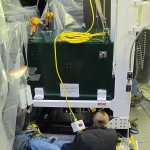An incredible amount of planning and work went into the job, with everything culminating in a few days of frenetic activity. Often referred to as “twins”, the Keck telescopes seem anything but. Over the years these once identical twins have taken on their own characteristics. One of the things that differentiates the two, each has its own set of unique instruments. Cameras and spectrographs, these multimillion dollar devices allow the recording and studying of the light collected by the massive 10-meter mirrors. This week we moved one of these instruments from Keck 2 to Keck 1… OSIRIS.
OSIRIS is an infrared integral field spectrograph. Designed to take full advantage of the Keck Adaptive Optics systems, the instrument has a relatively small field of view. Within that small field it does amazing things, providing a simultaneous spectrum and image of an object. Essentially it takes a stack of images at the same time, each at a different wavelength. This gives astronomers a very powerful tool. One image will show the distribution of particular elements throughout an object. Using doppler shift, an astronomer can also observe how everything is moving within the object as well.

The Keck crew lowering OSIRIS into Keck 1 AO
Moving an instrument is not a trivial job. It is not simply a matter of unplugging the instrument and moving it to the other telescope. Each instrument has a tremendous amount of infrastructure required to support it. Electrical wiring, optical fibers, plumbing for the cooling systems, support computers, and more… All of it has to be moved.
OSIRIS has been a removable instrument, mounted to a handling cart for easy removal and installation into the telescope. The new installation will be a permanent mount within the AO enclosure. A new mount must be designed and fabricated. New support beams welded and bolted into place. There are openings to be cut into the floor for the mounts and support connections. Then all of the electrical, optical cabling and plumbing run through the structure of the telescope. This all has to be designed, reviewed and then the modifications performed without interfering with nightly observing. The amount of work is truly daunting, and thanks to the efforts of a great crew, now complete.
Finally, it is time to physically move the instrument itself…

Securing OSIRIS into the Keck 1 Adaptive Optics enclosure
Stepping into the building I was surprised by a set of white tracks down the central hallway. No need to ask, it was clear, OSIRIS had been here. The instrument had been rolled down the hallway from Keck 2 to Keck 1 the previous day. The massive weight had powdered the floor wax used in the hallway, leaving a pair of obvious tracks.
With OSIRIS on the Keck 1 dome floor, this day would involve lifting it into place inside the AO enclosure. Two lifts would be required, first a frame would be lifted into place, then the dewar containing the instrument itself. Several million dollars worth of optics slung from a cable, 80 feet above the concrete floor, lifted by the shutter crane to its destination.
The Adaptive Optics enclosure is usually such a quiet place. An insulated enclosure built on the side of the telescope, a cleanroom where the needs of optics come first. The exclusive demesne of my fellow members of the AO team and I. We wear cleanroom coveralls, booties and bonnets, listen to the HEPA filters, and move deliberately to avoid disturbing careful alignments of the optical gear.
This day that peace was shattered. The room bustling with activity. Plastic sheets draped across much of the area in an attempt to limit the dust. A good idea as the roof gaped open to the dome, open to allow OSIRIS to be lowered into place.
I had intended just to stay on the periphery and take a few photographs, staying out of the way of the team. I got too close however, a pair of idle hands too close to work. A few barked orders from the team lead had me helping out, first just spotting as the instrument was lowered into place, eventually helping heave as bolts found threads and the instrument was secured to its frame. I did get some decent photos in the process.
OSIRIS is safely stowed into its new home. Much remains to be done, carefully aligning the instrument, pumping the dewar to restore the vacuum, then cooling the detectors and test everything for correct operation. If all is well, OSIRIS will return to science operation later this year.

